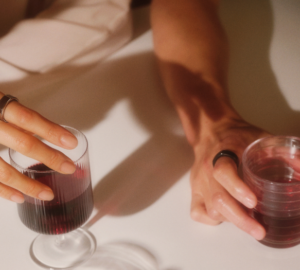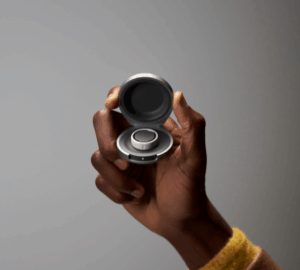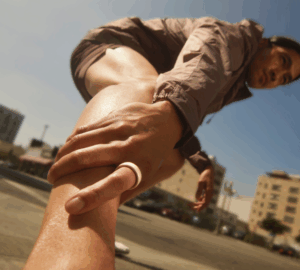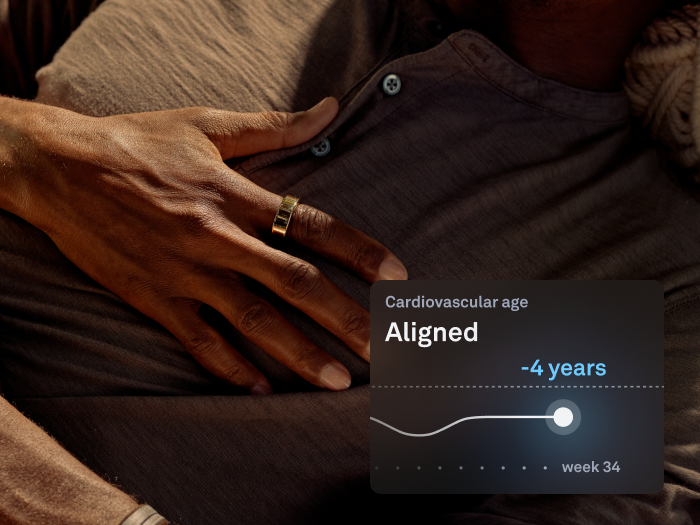You know how old you are — but do you know how old your heart is?
Cardiovascular Age (CVA) provides an estimate of how your heart and large arteries are aging compared to your chronological age, as well as guidance on how you can improve your heart health in the long run. When used in conjunction with other Oura insights, it provides a more comprehensive view of your overall health.*
“Oura’s Science Team partnered with board-certified cardiologists and scientists at research institutions to rigorously develop and validate our science and algorithms to ensure this feature deliver accurate insights for our wide-ranging and diverse member base,” notes Shyamal Patel, PhD, Senior Vice President of Science at Oura.
No matter your (actual) age, it’s possible to improve your cardiovascular health with healthy habits and lifestyle changes. Below, learn more about CVA, why it matters, and more about the new research-backed biometric Oura Ring senses to determine it.
RELATED: How to Lower Your Cardiovascular Age—According to Oura Members Who Have
Track Your Cardiovascular Age With Oura
Oura members with 14 nights of data in the Oura App will receive a Cardiovascular Age metric that indicates how their CVA aligns with their actual age. Find this metric in the My Health tab.
Cardiovascular Age is categorized into three levels:
- Younger than actual age: -5 years and below
- Aligned with actual age: between -5 and +5 years
- Older than actual age: +5 years and higher
In the Oura App, you can see month-over-month views of your CVA. As of April 2025, you can add custom Tags and activities to understand how specific lifestyle choices and behaviors may impact your long-term heart health. Oura also highlights Trends in your CVA to provide more insight into changes over time.
What Is Arterial Stiffness?
Photoplethysmography (PPG) sensors and photodetectors can be used to estimate your pulse wave velocity (PWV), or the speed at which your heartbeat pulse travels throughout your body. PWV is widely used as the gold-standard measurement of arterial stiffness, which increases over time—hence the connection to biological age.
Large arteries are blood vessels that carry oxygenated blood from the heart to the rest of the body. When you’re young and healthy, your arteries tend to be more elastic or flexible — easily adapting to varying blood flow demands.
As you age, your arteries naturally become less flexible or stiff — a process known as large artery stiffening. As arteries stiffen, the speed at which your blood flows through them, or PWV, speeds up. (More on why this matters, below.)
While age is the primary cause of this stiffening process, studies show that lifestyle factors such as smoking, an unhealthy diet, poor sleep, or a sedentary lifestyle, as well as health conditions such as high blood pressure, high cholesterol, or obesity, can also speed it up.

Why Arterial Stiffness Matters
“Think of your arteries as shock absorbers,” explains Pauli Ohukanien, PhD, Senior Research Scientist at Oura. “The large arteries of the body work to cushion the pressure waves generated by the heart, while the smaller arteries are not designed to handle such high forces.”
“As large arteries stiffen, they lose their cushioning ability, and smaller arteries in sensitive organs, such as the brain, kidneys, and the heart itself, become subjected to abnormal physical strain,” he says.
Advanced arterial stiffness can lead to increased risk for several cardiovascular diseases including heart disease, stroke, and heart failure. Plus, it can be a contributor to other illnesses, such as kidney disease and Alzheimer’s disease, Ohukainen notes.
PWV: An Unsung Heart Health Metric
When it comes to heart health metrics, most people think about resting heart rate, heart rate variability, blood pressure, or cholesterol.
Pulse wave velocity (PWV), or the speed at which blood flow travels through your arteries, is a lesser-known, yet extremely important, signal of your overall heart and circulatory system health. Arterial stiffness is directly related to pulse wave velocity (PWV), meaning that as arterial stiffness increases, so does the PWV; essentially, a stiffer artery allows the pressure wave to travel faster through the arterial system, resulting in a higher PWV value, which is considered a key indicator of arterial stiffness.
“While a data point like your cholesterol level or blood pressure provides a snapshot of your health, PWV provides an estimate of your cumulative exposure to the totality of lifestyle factors from a lifetime,” Ohukainen explains.
Think of PWV as a slower-moving, longer-term metric that is within your control to improve, no matter your age. However, it is important to note that some acute stressors may cause arteries to stiffen on a shorter-term basis, which may show up as increased PWV, Ohukainen notes. “Causes may include illness, exceptionally stressful experiences, very cold outside temperatures, and for some people, higher-than-usual dietary salt intake.”
Scientific studies published in peer-reviewed literature have established normal reference ranges for age-related PWV values (shown below).
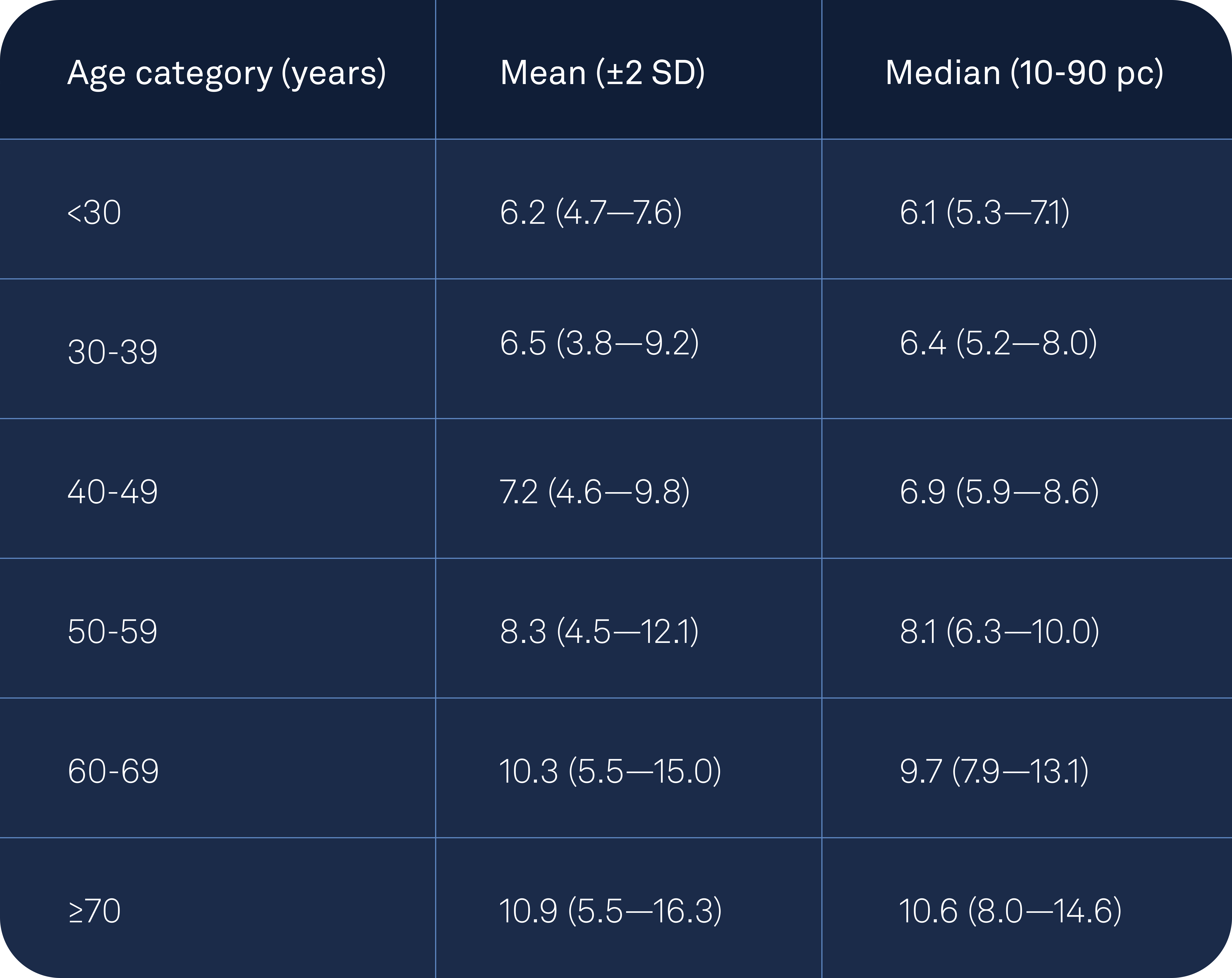
How Oura Ring Detects Blood Flow
Directly measuring PWV typically requires specialized medical equipment that can detect the timing of the pulse wave at two different arterial sites, which isn’t feasible with most consumer wearable devices like Oura Ring. However, Oura Ring is equipped with advanced sensors, such as infrared photoplethysmography (PPG) sensors, that monitor blood volume changes in your finger. While these sensors don’t measure PWV directly, they can capture data related to your blood flow.
By analyzing the PPG signals, Oura Ring can extract features that correlate with PWV. This means it can estimate changes in arterial stiffness and blood flow characteristics indirectly. These estimates serve as a PWV-proxy, providing insights similar to what a direct PWV measurement would offer.
The infrared photoplethysmography (PPG) sensors in Oura Ring send light through LEDs into the skin. As your pulse wave travels through your arteries, it causes subtle changes in blood volume. Photodetectors in the ring can then quantify blood flow based on variations in light absorption (PPG signal).
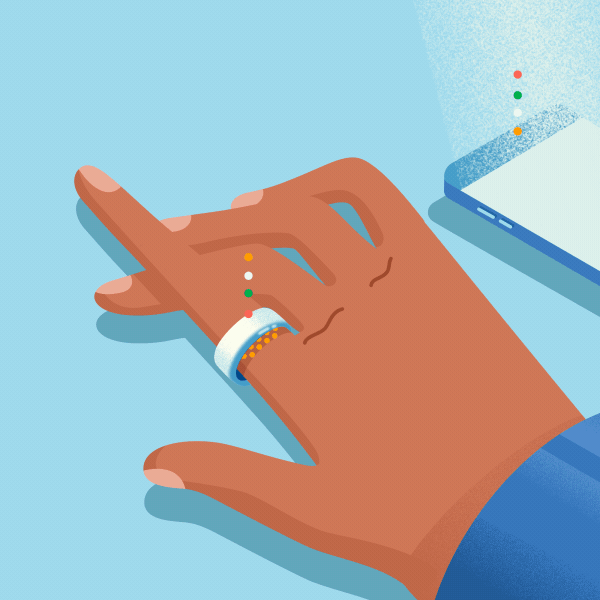
How Does Oura Translate PPG Signals Into CVA?
Oura bases its CVA estimation on anonymized data from hundreds of thousands of members.
“Oura’s research team analyzed vast amounts of PPG signals and discovered that certain features correspond relatively well with members’ chronological ages, yet considerable variability remained,” Ohukainen says. “We sought to explore whether this variability could be explained with differences in age-related arterial changes.”
Oura’s Science Team conducted clinical studies with 600 participants in collaboration with external partners, such as the Kuopio Research Institute of Exercise Medicine (KuLTu) and UCLA, to understand the exact roots of PPG signal shape.
The result: PPG Signal shape is indeed closely related to general health metrics such as arterial stiffness and chronological age. Combining both the data from the member base and external clinical studies, Oura developed an algorithm that evaluates cardiovascular health by providing a key estimate: Cardiovascular Age. This estimate may help users understand and monitor their heart health.
Why CVA Matters
Your CVA provides valuable insight into the function of your cardiovascular system and your overall health. Having a CVA that’s below or aligned with your actual age is a positive indicator of your overall cardiovascular health today and your long-term health span.
If your CVA is higher than you’d like it to be, Oura will give you insights and guidance on potential steps you can take to lower it, such as exercising more or reducing dietary sodium. For more information on improving your CVA, check out this blog.
In conjunction with the other metrics Oura provides, such as resting heart rate, heart rate variability, sleep patterns, and activity progress, CVA will give you a more comprehensive, holistic, and long-term picture of your overall health.
Remember: Heart health is not static and doesn’t change overnight. Rather, it evolves gradually over time due to various factors such as aging, lifestyle habits, and underlying health conditions.
Taking a proactive approach to heart health enables timely interventions, awareness, and the ability to optimize your health so you can live healthier, longer.
*ŌURA products and services are not medical devices, and are not intended to mitigate, prevent, treat, cure or diagnose any disease or condition. If you have any concerns about your health, please consult your doctor.
About the Oura Experts
Pauli Ohukainen, PhD, is a Senior Research Scientist at Oura’s Future Physiology Team, where he is responsible for designing and leading clinical cardiometabolic research projects. Ohukainen has an M.Sc in biochemistry and molecular biology. He did his PhD in the department of Pharmacology and Toxicology, University of Oulu, Finland, on the molecular mechanisms of human aortic valve calcification. He has published more than 20 peer-reviewed articles, and has been a PhD supervisor and a lecturer for medical students.
Shyamal Patel, PhD, is Senior Vice President of Science at Oura, where he leads an interdisciplinary organization focused on research and development of algorithms that translate sensor data into accurate measures of health and wellbeing. He is passionate about building digital health solutions that enable the transformation of healthcare from a largely subjective, episodic, and reactive model to become more objective, continuous, and proactive. Before Oura, Shyamal has led data science teams in several startups as well as large companies. Most recently he was at Pfizer where his work was focused on development, validation, and deployment of new digital endpoints across multiple therapeutic areas in regulated clinical trials. Shyamal has a PhD in electrical engineering with a specialization in signal processing and applied machine learning from Northeastern University. He completed his post-doctoral research at Harvard University and lives in Boston.








